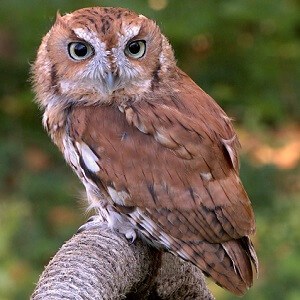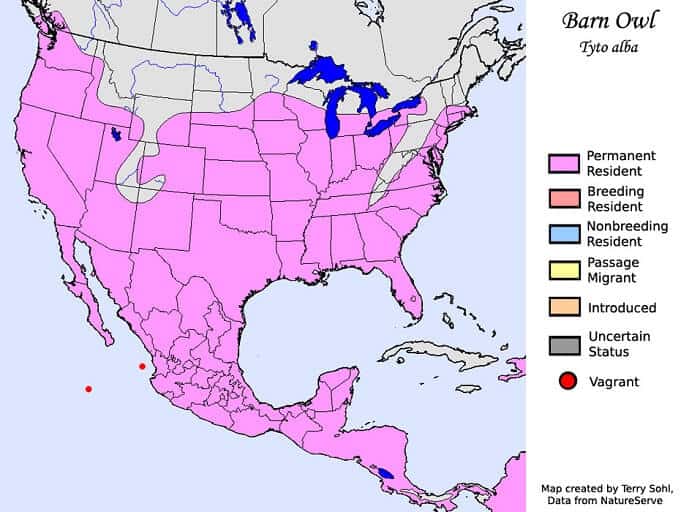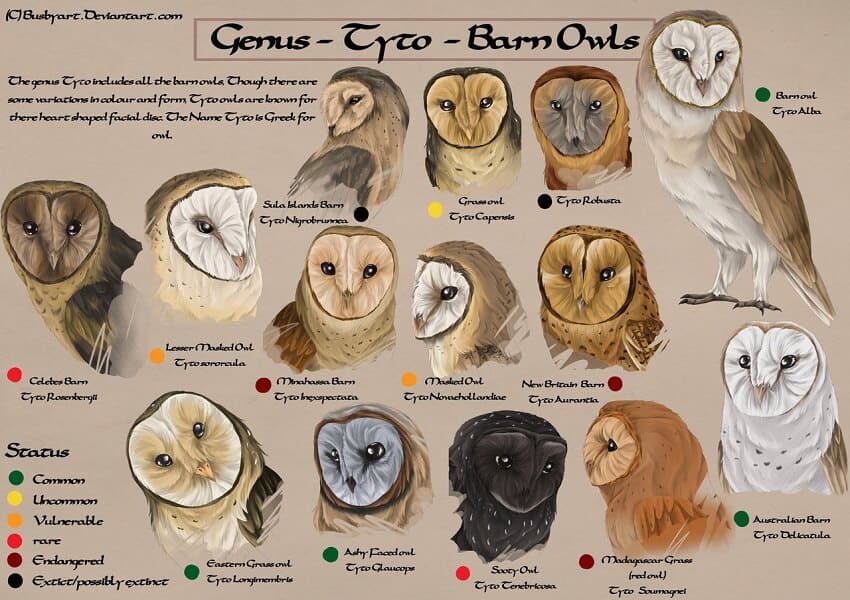Not All Owls Are Nocturnal
You’ve probably heard of the term night owl, which makes sense at first glance. One of the most well-known owl facts for kids is that most owl species are nocturnal creatures, which means that they are only active at night. This makes owls unusual because most birds are only active during the day. It’s a distinct advantage because it means that owls can hunt at night without the competition of other birds of prey, such as hawks and eagles. And less competition means more food. Midnight snack, anyone? But some owls simply aren’t night owls at all and don’t hunt at night. Some species, such as short-eared owls, snowy owls and burrowing owls, actually hunt during the day. Another deviation from the norm is owl species that hunt at dusk and dawn, such as pygmy owls. So much for being a night owl!
Owls Live in Some Unusual Places, Such as Cacti
Did you ever imagine that a prickly cactus could be a home? Owls live in a wide range of habitats and can be found on all continents except for Antarctica. If you journey to the Sonoran Desert, you might be lucky enough to witness one of the strangest owl facts for yourself: an elf owl in its residence – a cactus. Gila flickers, a specific type of woodpecker, create great excavations in saguaro cacti, which elf owls then use as convenient nesting sites. Pygmy owls will nest in saguaro and organ pipe cacti, whilst great horned owls are known to build nests in the crooks of these cacti. So much for soft furnishings… Owl facts teach us that the majority of owls do not migrate. However, they can be nomadic when searching for abundant sources of food.
Owls Are Cannibals
It turns out that cannibalism is not just for the movies! The majority of the 200 species of owls eat insects, small mammals, and other birds, while others hunt fish. One of the better known owl facts is that farmers often keep barn owls to help them control the rodent population in their agricultural fields. In order to catch their prey, owls have zygodactyl feet. In other words, two toes point forwards and two toes point backwards. These toes are equipped with strong sharp talons to help them snatch up their prey. Owls swallow small prey whole and, as they have no teeth, they tear larger prey into smaller pieces. And, sometimes, that prey is other owls. Yes, you read that correctly! One of the more fascinating owl facts is that owls can be regarded as pseudo cannibals due to the fact that they have been known to eat owls from other species. For example, the great horned owl is the main predator of the smaller barred owls. But barred owls are not so innocent themselves – they, in turn, eat even smaller owls. It is thought that owl-on-owl predation is partly to blame for the declining Western screech owl population in the Pacific Northwest.
Silent but Deadly: Owls Are the Quietest Birds of Prey
Owls are considered birds of prey, but they are much quieter in flight that other birds in this category. This enables them to swoop down on unsuspecting prey and snatch them up before they know what’s hit them. Owls are the original silent killers. An owl’s wing feathers are specially adapted to have hooks on the front that silence the surrounding airflow. The primary feathers create stiff fringes that eliminate sound. The sound of their flight is further muffled by the soft fringes of the primary feathers’ trailing edges that decrease turbulence. Finally, the entire surface of their wings is covered in downy feathers, which quietens the sound of their flight even more. These owl facts, together with the fact that owls have light bodies and broad wings, helps us to understand why they are such silent predators.
Owls Can Rotate Their Necks as Much as 270 Degrees
Incredibly, owl facts reveal that owls can rotate their necks as much as 270 degrees. Talk about being able to watch your back! Just try to do that and you’ll see how impossible it is for us humans! Owls are able to achieve this incredible rotation thanks to the fact that they have 14 vertebrae in their necks – double the number generally found in birds’ necks. Although this cuts off blood circulation, owls’ bloodstreams are designed to pool blood that is used to feed the head and eyes. This ability to rotate their necks so much might sound unnecessary, but it is important that they are able to do this because owls are unable to turn their eyes within the bony eye sockets. This is because their large ‘eyeballs’ are actually tubular in shape, and there is no space for the muscles necessary for movement, making them completely immobile. The ability to rotate their necks also compensates for the vulnerability of having forward-facing eyes. Owls’ eyes face forward, giving them binocular vision, like people. This enables them to have enhanced depth perception whilst focusing on their prey. Although owls have good long-distance vision, what many people don’t realize is that they are far-sighted, meaning that they cannot focus clearly on things close to them. Another unusual piece of information pertaining to their eyes is the fact that owls have three eyelids for each eye. One eyelid is for blinking, another for sleeping, and the third is to keep the eye healthy and clean.
Owls Have Superior Hearing thanks to Their Asymmetrical Ears and Flat Face
One of the lesser known owl facts is that several species of owls have ears that are different sizes and located at different heights on their head. This isn’t a random feature that simply makes them look funny; it heightens their ability to hear and locate their prey. The tufts on an owl’s head are not actually ears. These are tufts of feathers that may help with camouflage, indicate the owl’s mood, and display aggression. The flat face that characterizes owls is actually designed to enhance their hearing. The flattened facial disk funnels sounds to an owl’s ears, magnifying it up to ten times. This enables owls to hear sounds that the human ear can’t detect.
Female Owls Have the Characteristics Usually Associated with Males Birds
So, who wears the trousers in the owl world? Although the call of a female owl is usually higher in pitch than that of a male owl, there are many characteristics belonging to female owls that we usually associate with the males in other bird species. This is where owl facts really differ from other bird facts. Generally, the female owl is larger, heavier and more aggressive than the male. In the case of dimorphic owls (where the male and female differ in appearance) the female is generally more richly colored than the male. This contradicts most people’s assumptions about discerning the difference between a male and female bird.
Not Just Hooting: Owls Can Also Screech, Whistle, Bark, Rattle, Hiss and Growl
Do you ever listen out for the hooting of owls at night? You might be left waiting quite a while if so! Although most people associate owls with hooting, owls facts reveal that these birds can also screech, whistle, bark, rattle, hiss, and growl. In fact, some owl species do not hoot at all. In the far north, snowy owls are known to produce a squeaking call similar to that of a seabird. Pygmy owls and other small owl species make dull whistling sounds. It’s also interesting to note that the screech owl is a misnomer – it doesn’t screech at all. Its call consists of a series of quick whistling toots, which have a bouncy quality to them. If you do hear what seems to be an owl screeching, it is more likely to be a juvenile great horned owl than anything else. In general, owls’ calls are loud and low-pitched. Owl calls can be heard up to a mile away, especially during nesting season. These calls are used by owls to locate their mates and declare their territories.
A Group of Owls Forms a Parliament
Whilst one of the generally accepted owl facts is that the collective noun for owls is a parliament of owls, there seem to be many other variations. Some of the more popular variations include a wisdom, stare or study of owls. For a more extensive look at the subject, you might want to read this list of possibilities:
- A bazaar of owls
- A brood of owls
- An eyrie of owls
- A hooting of owls
- A looming of owls
- A stooping of owls
- A brood of owlets
- A diss of owls
- A sagaciousness of owls
- A stable of Barn Owls
- A jail of Barred Owls
- A prohibition of Barred Owls
- A schizophrenia of Hawk Owls
- A volery of Little Owls
- A blizzard of Snowy Owls
It is interesting to note that the noun a parliament of owls only originated in the 1950s. The author CS Lewis adapted the title of Chaucer’s poem The Parliament of Fowls when describing a gathering of owls in his classic children’s series The Chronicles of Narnia. His books have sold more than 100 million copies in 47 languages. It is due to this incredible popularity that parliament of owls has become the accepted correct collective noun for owls.
Owls are Associated with Bad Luck, Death, and the Stealing of Souls
There are several superstitious beliefs pertaining to owls that contradict the image of a wise owl. Most of these superstitions refer to bad luck, death, or the stealing of souls. Owls are also often associated with witchcraft. In addition, along with bats and spiders, owls are a common theme in Halloween motifs, decorations, and costumes. Owls are so-called because of their cry: ‘owl’ comes from the word ‘howl’. In other words, the owl’s cry is associated with a howl, or lament. It is this mournful sound, together with their nocturnal habits, that have led to owls being associated with death and ill-fortune across so many cultures. These superstitions, which are not based on sound owl facts, unfortunately lead to the persecution of owls, which is one of the more common modern threats to all owl species.
Owl Facts – Facts about Owls Summary
 Owls are nocturnal birds of prey that live in almost all habitats. Their bodies are specially designed to help them hunt for prey, which can include other owls. They are often the subject of superstitious beliefs, which in turn leads to their persecution in many cultures.
Owls are nocturnal birds of prey that live in almost all habitats. Their bodies are specially designed to help them hunt for prey, which can include other owls. They are often the subject of superstitious beliefs, which in turn leads to their persecution in many cultures.
Owl Facts



No comments:
Post a Comment